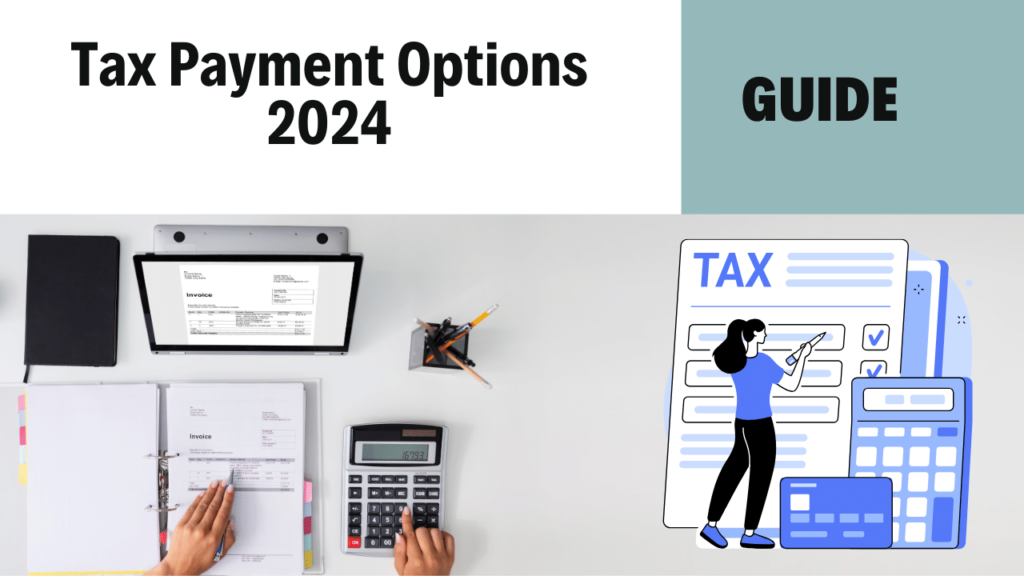Fulfilling civic responsibilities includes the crucial aspect of paying taxes, and the IRS offers several Tax Payment Options for taxpayers to meet their financial obligations. In this blog post, we will explore the different Tax payment options provided by the IRS, ensuring that individuals and businesses alike can seamlessly remit their dues.

U.S. tax payments represent a crucial aspect of fiscal responsibility, and it’s important to be aware of the specific guidelines governing these transactions. One significant requirement to note is that U.S. tax payments must be made exclusively in U.S. dollars. This means that any form of digital assets, such as cryptocurrencies or other virtual currencies, is not accepted as a valid means of settling tax obligations.
Various Tax payment options available:
1. IRS Direct Pay
Pay your tax bill or estimated tax payment directly from your checking or savings account at no cost by visiting IRS.gov/Payments.
2. Debit Card, Credit Card, or Digital Wallet
Choose an approved payment processor to pay online or by phone. Visit IRS.gov/Payments for a list of approved processors and detailed guidelines.
3. Electronic Funds Withdrawal
Schedule a payment when filing your federal taxes using tax return preparation software or through a tax professional.
4. Electronic Federal Tax Payment System (EFTPS)
This electronic payment system is ideal for businesses, and enrollment is required. Enroll at EFTPS.gov to make secure payments.
5. Check or Money Order
Mail your payment to the address listed on the notice or instructions. Follow the instructions provided by the IRS and ensure timely delivery.
6. Cash
Pay your taxes with cash at a participating retail store after confirming eligibility and following the provided instructions.
7. Same-Day Wire
Explore the option of making a same-day wire from your financial institution. Contact your financial institution for availability, cost, and time frames.
The IRS emphasizes the security of electronic payments, utilizing the latest encryption technology to ensure the safety of online payments made through IRS2Go or other channels. Electronic payments offer a secure, quick, and efficient alternative to traditional methods.
Also Read: Tax Brackets for 2024
For those facing challenges in paying their taxes immediately, the IRS provides alternative Tax payment options:
1. Online Payment Agreement (OPA)
Apply for an online payment agreement to meet your tax obligation in monthly installments by visiting IRS.gov/OPA.
2. Offer in Compromise (OIC) Pre-Qualifier
Check if you can settle your tax debt for less than the full amount you owe using the pre-qualifier tool at IRS.gov/OIC.
Understanding the array of payment options offered by the IRS empowers taxpayers to fulfill their obligations with ease. Whether you prefer the convenience of online payments or the traditional approach of mailing a check, the IRS accommodates various preferences, ensuring a smooth and secure tax payment experience.
Conclusion
In conclusion, understanding the diverse tax payment options provided by the IRS is pivotal for every taxpayer. Navigating the realm of tax payments may seem intricate, but the array of choices available ensures flexibility and convenience for individuals and businesses alike.
Whether opting for the seamless IRS Direct Pay, utilizing electronic methods, or considering alternative arrangements when facing financial constraints, taxpayers have the tools they need to meet their obligations. The IRS’s commitment to security, evident in their use of cutting-edge encryption technology, further underscores the reliability of electronic payment methods.
As you embark on your tax payment journey, always remember that the IRS prioritizes accessibility and provides resources for those encountering difficulties. The Online Payment Agreement (OPA) and Offer in Compromise (OIC) programs offer viable solutions, allowing you to meet your obligations without undue strain.
This blog serves as a comprehensive guide, but it’s essential to stay updated on any changes or additional details by referring to the official IRS website. Your commitment to fulfilling your tax responsibilities contributes to the well-being of our society, ensuring the continued functioning of essential services.
Thank you for exploring the intricacies of tax payment options with us. May your financial transactions with the IRS be smooth, secure, and stress-free. If you have any further questions or need specific information, the IRS website is your reliable source for the latest updates and guidelines. Happy tax-paying!
Note: This blog post serves as a general guide. For specific details and to stay updated on any changes, always refer to the official IRS website.
